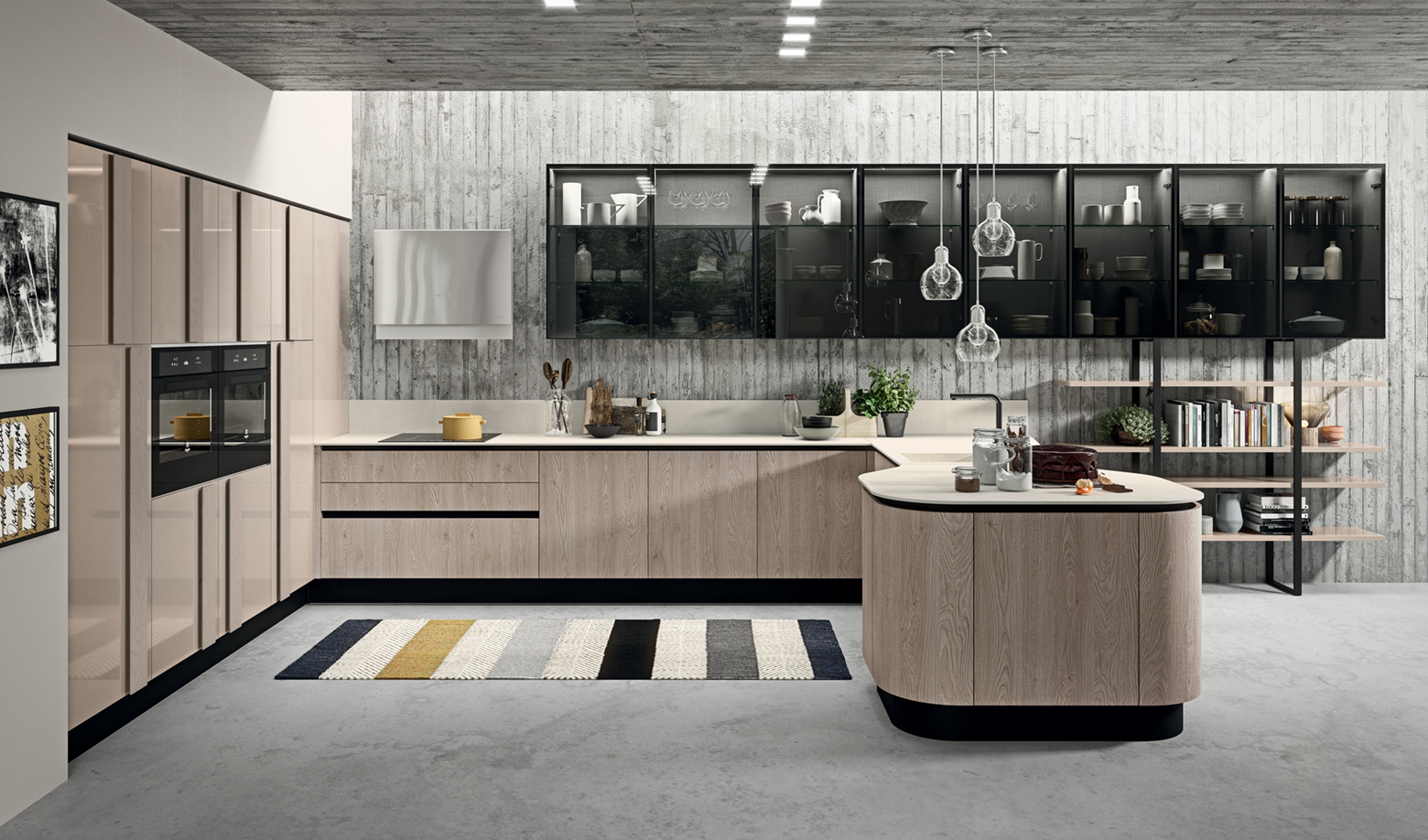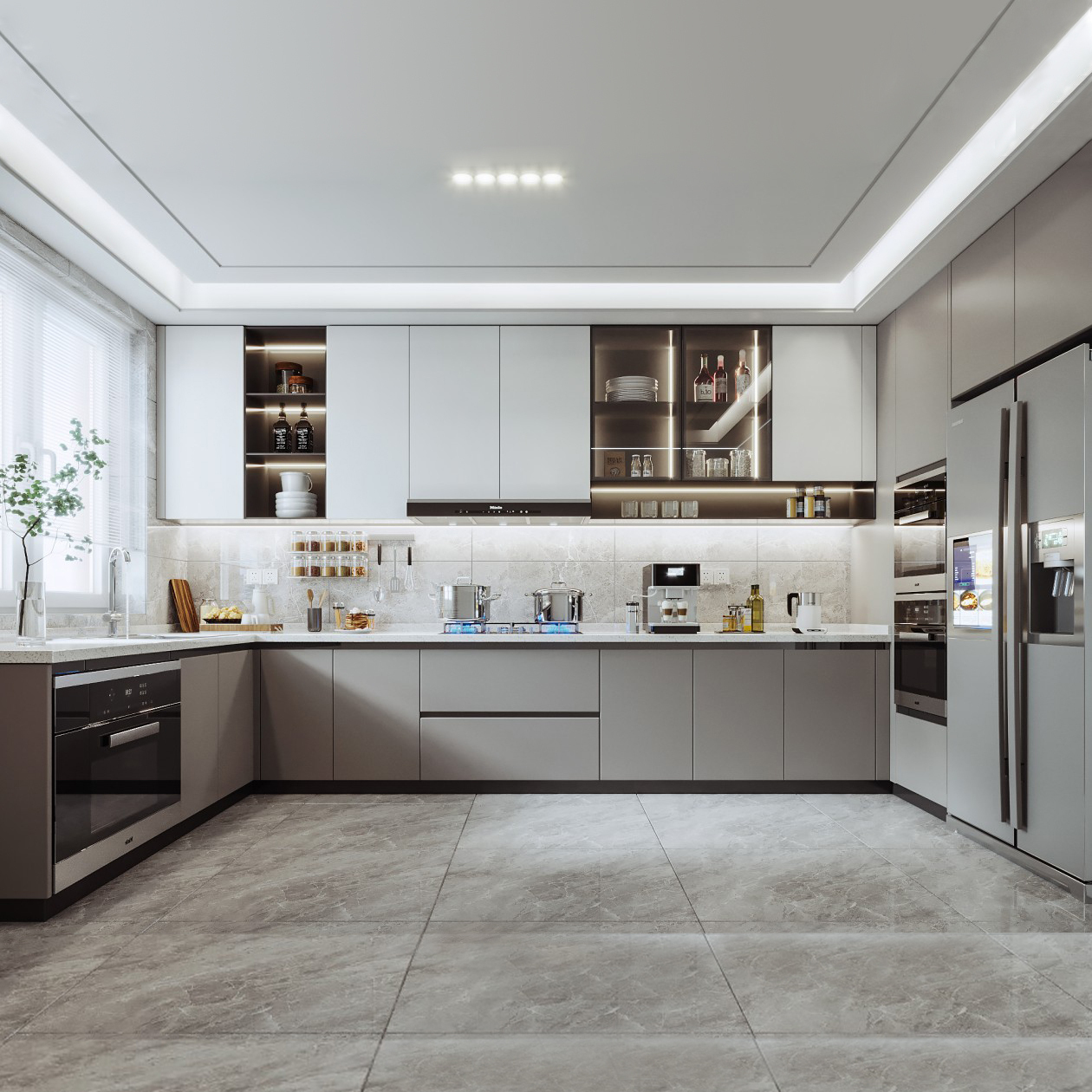Modern European Kitchen Cabinet Styles

Modern European kitchen cabinets are renowned for their sleek aesthetics, functionality, and high-quality craftsmanship. These cabinets seamlessly blend contemporary design principles with practical considerations, creating kitchens that are both stylish and efficient.
Key Design Elements
Modern European kitchen cabinets are characterized by minimalist lines, sleek finishes, and functional storage solutions. The focus is on creating a clean, uncluttered look that maximizes space and enhances the overall aesthetic appeal of the kitchen.
- Minimalist Lines: Modern European cabinets typically feature simple, geometric shapes and straight lines, avoiding unnecessary ornamentation or embellishments. This creates a sense of order and clarity, allowing the beauty of the materials and craftsmanship to take center stage.
- Sleek Finishes: The surfaces of modern European cabinets are often smooth and polished, with a focus on high-quality materials like lacquered wood, high-gloss laminates, or stainless steel. These finishes reflect light, creating a sense of spaciousness and sophistication.
- Functional Storage Solutions: Modern European kitchen cabinets are designed to maximize storage space while maintaining a streamlined appearance. This is achieved through features like integrated pull-out drawers, hidden compartments, and clever use of vertical space. The emphasis is on creating a highly organized and efficient kitchen environment.
Different Modern European Kitchen Cabinet Styles
There are several distinct modern European kitchen cabinet styles, each with its own unique characteristics and aesthetic appeal.
- Scandinavian: Scandinavian kitchen cabinets are known for their minimalist design, use of natural materials like wood and light colors, and emphasis on functionality. They often feature open shelving, integrated appliances, and a focus on clean lines and natural light.
- German: German kitchen cabinets are renowned for their meticulous craftsmanship, attention to detail, and high-quality materials. They often feature a more traditional aesthetic with intricate carvings and elaborate hardware, but still maintain a clean and modern look. German cabinets are known for their durability and long lifespan.
- Italian: Italian kitchen cabinets are known for their sophisticated and stylish design, often incorporating bold colors, luxurious materials, and a focus on artistry. They can range from minimalist and sleek to more elaborate and ornate, but always maintain a sense of elegance and refinement.
Materials Used for Modern European Kitchen Cabinets
Modern European kitchen cabinets are crafted from a variety of materials, each offering unique advantages in terms of aesthetics, durability, and cost.
- Wood: Wood is a popular choice for modern European kitchen cabinets due to its natural beauty, durability, and versatility. It can be stained or painted to achieve a wide range of finishes, and it can be used to create both minimalist and more traditional designs. Popular wood species include oak, maple, cherry, and walnut.
- Laminate: Laminate is a more affordable alternative to wood, offering a wide range of colors, patterns, and textures. It is also highly durable and resistant to scratches, stains, and moisture, making it a practical choice for kitchens. Laminate cabinets can be used to create a modern, sleek look, and they are often available in high-gloss finishes.
- Metal: Metal is increasingly being used for modern European kitchen cabinets, particularly for accents and hardware. Stainless steel is a popular choice due to its durability, resistance to corrosion, and sleek appearance. Aluminum is another option, offering lightweight construction and a modern look.
Pros and Cons of Different Modern European Kitchen Cabinet Materials
| Material | Pros | Cons |
|---|---|---|
| Wood | Natural beauty, durability, versatility, can be refinished | More expensive than laminate, susceptible to scratches and moisture |
| Laminate | Affordable, durable, resistant to scratches, stains, and moisture, wide range of colors and patterns | Can look less natural than wood, may not be as durable as wood in the long term |
| Metal | Durable, resistant to corrosion, sleek appearance | Can be expensive, may not be as warm or natural looking as wood |
Features and Functionality

Modern European kitchen cabinets are renowned for their seamless integration of functionality and aesthetics. They are designed to optimize space utilization, enhance workflow, and create a sleek, minimalist ambiance. The key to achieving this lies in the unique features and functionalities incorporated into these cabinets, which go beyond mere storage solutions.
Integrated Appliances, Modern european kitchen cabinets
Integrated appliances are a hallmark of modern European kitchen design. These appliances, such as ovens, refrigerators, dishwashers, and microwaves, are seamlessly integrated into the cabinet structure, creating a unified and clutter-free aesthetic. This approach not only enhances the visual appeal of the kitchen but also maximizes space efficiency.
Integrated appliances create a seamless and unified kitchen design, minimizing visual clutter and maximizing space utilization.
Hidden Storage Compartments
Modern European kitchen cabinets often feature cleverly concealed storage compartments. These compartments are designed to keep everyday items organized and out of sight, contributing to a minimalist and uncluttered kitchen environment. Some common examples include:
- Pull-out pantries: These narrow, deep drawers provide ample storage for pantry items and can be easily accessed with a simple pull. They are a space-saving alternative to traditional pantries.
- Under-sink organizers: These organizers utilize the often-wasted space under the sink to store cleaning supplies, garbage bags, and other essential items, keeping them hidden from view.
- Revolving corner cabinets: These cabinets maximize the often-underutilized corner space by allowing for easy access to items stored within. They rotate smoothly, ensuring that every item is within reach.
Ergonomic Design
Ergonomics plays a crucial role in modern European kitchen design. Cabinets are designed with features that promote comfort and ease of use. For example:
- Soft-close drawers and doors: These features prevent slamming and noise, creating a peaceful and serene kitchen environment. They also extend the lifespan of the cabinets by minimizing wear and tear.
- Adjustable shelves: These shelves allow for customization to accommodate items of varying sizes, ensuring that all storage space is utilized efficiently.
- Pull-out drawers with integrated organizers: These drawers provide easy access to frequently used items and can be equipped with organizers to keep items separated and readily available.
Modern European Kitchen Layout
A modern European kitchen layout often incorporates an open-plan design, seamlessly connecting the kitchen with the dining and living areas. This layout promotes a sense of spaciousness and encourages social interaction. The placement of cabinets is strategically planned to optimize workflow and create a functional and aesthetically pleasing space.
- Island or peninsula: A central island or peninsula serves as a focal point, providing additional countertop space for food preparation, dining, or casual seating. It can also incorporate integrated appliances, such as a sink or cooktop.
- Wall-mounted cabinets: Wall-mounted cabinets provide ample storage space without taking up valuable floor area. They can be arranged in a variety of configurations to suit the specific needs of the kitchen.
- Base cabinets: Base cabinets are typically placed along the perimeter of the kitchen, providing storage for larger items, appliances, and kitchen essentials.
Innovative Storage Solutions
Modern European kitchen design emphasizes creative and efficient storage solutions. These solutions are designed to maximize space utilization and maintain a clutter-free environment.
- Vertical storage: This approach utilizes the vertical space in the kitchen, maximizing storage capacity. Tall cabinets, shelves, and organizers are used to store items that are not frequently used, keeping them out of sight but readily accessible.
- Magnetic strips: Magnetic strips can be attached to the walls or inside cabinet doors to store knives, utensils, and other metal items, freeing up countertop space and creating a visually appealing display.
- Under-cabinet lighting: Under-cabinet lighting illuminates the countertop and work areas, making it easier to prepare meals and enhancing the overall ambiance of the kitchen.
Color and Finish Options: Modern European Kitchen Cabinets

Modern European kitchen cabinets offer a wide range of color and finish options, allowing homeowners to create a unique and personalized space. These choices play a significant role in defining the kitchen’s aesthetic, mood, and functionality.
Color Palettes
Color palettes in modern European kitchens often lean towards a minimalist approach, prioritizing neutral and sophisticated tones.
- White: A timeless and versatile choice, white cabinets create a clean, airy, and spacious feel. They reflect light, making the kitchen appear brighter and larger. White pairs well with various countertop materials, backsplashes, and accent colors.
- Grey: Grey offers a more modern and sophisticated look compared to white. It provides a sense of calm and elegance while offering a neutral backdrop for various design elements.
- Black: Black cabinets create a dramatic and bold statement, adding a touch of luxury and sophistication to the kitchen. They work well with minimalist designs and can create a striking contrast against lighter countertops and backsplashes.
- Wood Tones: Natural wood tones bring warmth and a touch of rustic charm to modern European kitchens. Popular choices include oak, walnut, and maple, each offering a unique grain pattern and color variation.
Impact of Colors and Finishes
The choice of color and finish significantly influences the overall aesthetic and mood of the kitchen.
- Light Colors (white, cream, light grey): Create a sense of spaciousness, airiness, and brightness, making the kitchen feel larger and more inviting. They are particularly suitable for smaller kitchens or those with limited natural light.
- Dark Colors (black, navy, dark grey): Add drama, sophistication, and a sense of coziness. They can make the kitchen feel more intimate and luxurious, especially when paired with metallic accents.
- Warm Wood Tones (oak, cherry): Create a welcoming and inviting atmosphere, adding warmth and character to the space. They complement rustic and traditional design styles.
- Cool Wood Tones (maple, walnut): Offer a more contemporary and sophisticated look, blending well with modern and minimalist designs.
Examples of Modern European Kitchens
- White Cabinets with Black Countertops: A classic combination that creates a striking contrast and a sophisticated look. The white cabinets enhance the spaciousness of the kitchen, while the black countertops add a touch of drama and elegance.
- Grey Cabinets with White Countertops: A modern and versatile option that creates a clean and minimalist aesthetic. The grey cabinets provide a neutral backdrop for the white countertops, allowing the kitchen to feel airy and spacious.
- Walnut Cabinets with Concrete Countertops: A contemporary and stylish choice that combines natural wood tones with a modern industrial touch. The walnut cabinets bring warmth and character to the space, while the concrete countertops add a touch of ruggedness and sophistication.
Choosing the Right Color and Finish
When selecting the right color and finish for a modern European kitchen, consider the following factors:
- Kitchen Size and Layout: Light colors tend to make smaller kitchens feel larger, while dark colors can create a more intimate atmosphere in larger spaces.
- Natural Light: Light colors reflect light, making the kitchen brighter. Dark colors can absorb light, making the kitchen feel more cozy.
- Personal Style: Choose colors and finishes that reflect your personal taste and preferences.
- Existing Design Elements: Consider the existing design elements in the kitchen, such as the flooring, backsplash, and appliances, when choosing colors and finishes.
Modern European kitchen cabinets often prioritize sleek minimalism, incorporating integrated appliances seamlessly into the design. A popular choice for maximizing space and enhancing functionality is the under-cabinet microwave, which can be effortlessly installed using an LG under-cabinet microwave mounting kit.
This kit allows for a streamlined integration of the appliance, preserving the aesthetic harmony of the modern European kitchen design.
Modern European kitchen cabinets often prioritize minimalist design and functionality, emphasizing clean lines and efficient storage solutions. This trend extends to the integration of appliances, as seen in the growing demand for microwave storage cabinets in India , where sleek, built-in designs are becoming increasingly popular.
These cabinets not only provide dedicated space for the microwave but also contribute to the overall aesthetic coherence of the kitchen, aligning with the modern European emphasis on seamless integration and streamlined design.